
Female pot-bellied seahorse, Hippocampus abdominalis. I have seen this individual since September 2011 and on almost every dive at The Leap since November 2012.
Original: Sunday 18 January 2015 Update: Monday 31 August 2015
I recently completed my 100th dive at a dive site called The Leap at Kurnell and to celebrate the achievement I thought I would post why I love this site so much. I am happy to dive at The Leap every weekend. I will dive there twice on the same weekend, even twice on the one day. Why do I love it so? Read on...
The Leap is accessed from the Kurnell part of Kamay Botany Bay National Park and the entry point is literally a leap from a ledge into the water. I don't usually leap in as I am always carrying my camera and I take a much shorter route to the water. I have leapt in once and it is a great experience in itself. (Someone passed me my camera after I was already in.) While it is technically possible to exit at The Leap (the conditions have to be perfect), the most usual way to dive The Leap is to drift to The Steps (also known as Inspiration Point) some 500 metres along the shore to the north west.
After entering at The Leap and descending you swim perpendicular to the shore line at around 60° until you hit the sand line which is at a depth of just over 20 metres. The sand line directly out from the entry point is one of the many beautiful things about The Leap. There are a number of large rocks sitting on the sand and these rocks are covered in sponges of different colours and sizes. On and around the rocks you can find also sorts of interesting organisms. Once at the sand line you drift or swim in a north westerly direction along the sand line towards The Steps. It is important to look carefully on and around the rocks for cool critters such as anglers, seahorses, weedy seadragons and cuttlefish.
It is a long way from The Leap to The Steps and it is initially quite deep so you need to keep a close eye on your air and also non-decompression limit. When diving on air it is very easy to go into deco so you have to be vigilant or do as I do and dive on Nitrox. Depending on how good you are on air and how slowly you go it may not be possible to make it all the way to The Steps along the sand line and you may have to move into shallower water to conserve air. That's OK because there's still a lot of interesting stuff to see on top of the reef.
As an alternative to the normal dive at The Leap, and one that I am doing more often, is to swim south east along the surface parallel to the shore and then proceed to the sand line as before. This takes you to The Wall which is breathtaking in its beauty.
So why do I love The Leap? It is all the organisms I can and do see. Some I see regularly while others I only see occasionally or only once but just knowing that I can see them keeps me coming back. The other thing I love about The Leap is the beautiful scenery: the rocks covered in sponges of various colours and the wall right at the start of the dive are stunning.
Here's just a small selection of the organisms...
I have seen so many different organisms at The Leap it might be quicker to list what organisms (which can be seen in Sydney) I haven't seen. I haven't seen White's seahorses, any pipefish, striped anglers or many cephalopods frequently seen on might dives such as blue-lined octopus, pyjama, dumpling, and bottletail squid. I have pretty much seen everything else on dives at The Leap that I have seen in Sydney, although I haven't personally seen a grey nurse shark at The Leap even though others have.
Here's just some of the organisms you can see on a dive at The Leap: dolphins, Australian fur seals, green turtles, Port Jackson, crested horn and wobbegong sharks; fiddler rays, black stingrays, moray eels, striped catfish, frogfish, red-fingered and painted anglers, clingfish, pineapplefish, pot-bellied seahorses, pygmy pipehorses, weedy seadragons, velvetfish, red indianfish, goblinfish, lionfish, eastern blue devils, blue gropers, blotched hawkfish, pygmy leatherjackets, temperate and tropical boxfish, cowfish, sea spiders, octopus, giant, reaper and mourning cuttlefish, southern calamari squid, lots of nudibranchs, spindle cowries, lots of different sea stars, basket stars.
Syngnathids are probably my favourite organisms I see at The Leap and their are three main species: pot-bellied seahorses, Hippocampus abdominalis, weedy seadragons, Phyllopteryx taeniolatus and Sydney pygmy pipehorses, Idiotropiscis lumnitzeri. All three species can be seen at other locations than The Leap but The Leap for me is the most reliable place to see them. Some species of pipefish are also seen at The Leap but I am yet to see them myself.
Most of the pot-bellied seahorses can be found in the same location week after week and can be recognised by the patterns of spots on their heads and bodies. I have been watching one individual for over 3 years and I have seen as many as 6 different individuals on the one dive at The Leap. As I know where the seahorses are I can usually find them on every dive. Even if I don't find anything new on the dive, it is reassuring to find the seahorses which are like old friends.

Female pot-bellied seahorse, Hippocampus abdominalis. I have seen this individual since September 2011 and on almost every dive at The Leap since November 2012.
Weedy seadragons are quite common and it is rare that I don't see at least one individual on a dive. I have seen as many as 9 different individuals on a single dive and in 2014 alone I have seen a total of over 35 different weedy seadragons (which can be identified by the spots on their snouts). While the seadragons move around they are generally in the same area each time I see them. There is in an area about half way between The Leap and The Steps that I like to call Seadragon Alley because so many seadragons seem to congregate there. At various places along a dive at The Leap I often see males with eggs attached to their tails.
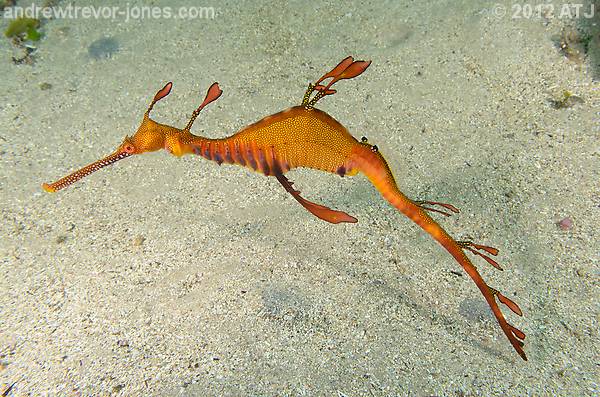
Weedy seadragon, Phyllopteryx taeniolatus.
I saw my first Sydney pygmy pipehorse as Oak Park, Cronulla in 2011. I then saw some at Bare Island, La Perouse at various times in 2013. It was not until one of my last dives at The Leap in 2013 that I finally saw one at The Leap. Since then I have seen 9 other different individuals on dives at The Leap, including pregnant males. The Sydney pygmy pipehorses can be a challenge to find because they are small and often well camouflaged but it is always rewarding to see them. Also see: Sydney Pygmy Pipehorses.
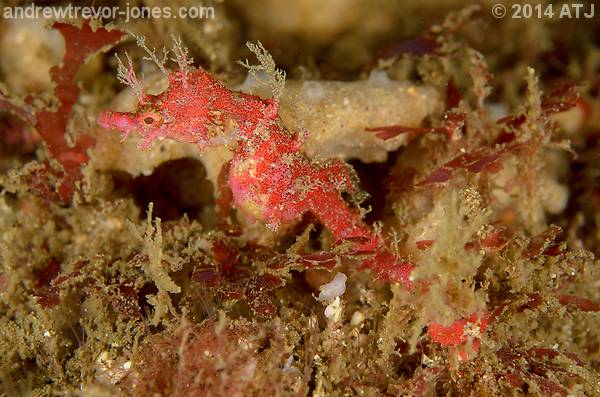
Male Sydney pygmy pipehorse, Idiotropiscis lumnitzeri.
There are three species of cuttlefish commonly seen in Sydney: giant cuttlefish, Sepia apama, reaper cuttlefish, S. mestus and mourning cuttlefish, S. plangon. I have seen all three species at The Leap. Reaper cuttlefish are by far the most commonly seen and it is rare not to see at least one on a dive at The Leap. Giant cuttlefish are probably the next most common and I have seen them anywhere from juveniles to large adults. I have only seen mourning cuttlefish on a few occasions and most of these were closer to The Steps.
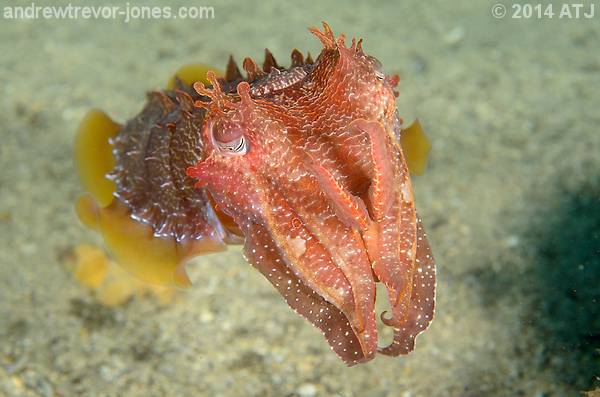
Juvenile giant cuttlefish, Sepia apama.
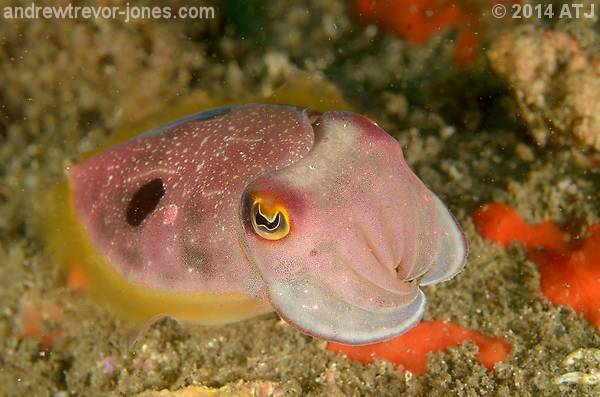
Reaper cuttlefish, Sepia mestus.
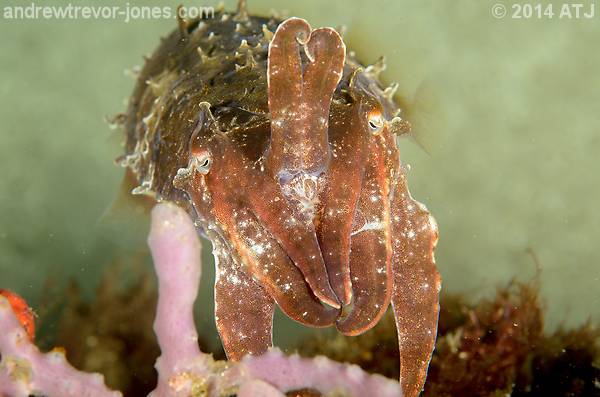
Mourning cuttlefish, Sepia plangon.
I have only seen one species of octopus at The Leap, the common Sydney octopus, Octopus tetricus. They are pretty common as they are throughout the Sydney area. The other two octopus species seen in Sydney: hammer octopus, O. australis, and blue-lined octopus, Hapalochlaena fasciata, tend to be more nocturnal and I have yet to do a full night dive at The Leap.

Common Sydney octopus, Octopus tetricus.
Southern calamari squid, Sepioteuthis australis, are seen regularly in schools out over the sand and sometimes on top of the reef. Most other squids seen in Sydney also tend to be nocturnal, like the octopus, and so unless I do a night dive at The Leap I'm not likely to see them.
I have seen two species of anglers at The Leap: painted anglers, Antennarius pictus, and the recently described red-fingered anglers, Porophryne erythrodactylus. I have only seen 3 painted anglers at The Leap although I have seen two others near The Steps at the end of a dive at The Leap. The time I ever saw a red-fingered angler was at The Leap in January 2011. Since then I have seen quite a few, mostly the grey form, but I have seen an orange form close to The Steps. I have not seen any striped anglers, Antennarius striatus, at The Leap but I am sure they must be around and I have seen one at Henry Head on the other side of Botany Bay. Also see: The Anglers of Kurnell.
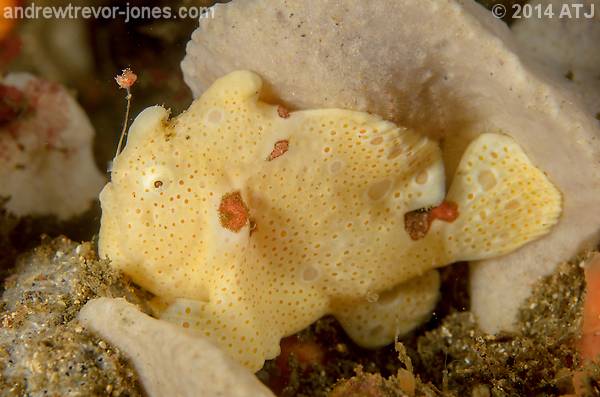
Painted angler, Antennarius pictus.

Red-fingered anglerfish, Porophryne erythrodactylus.
There are some unusual organisms that I have seen at The Leap. They are unusual not only because they are not seen often but also because they can be quite strange to look at.
One of the most unusual fish I have seen at The Leap is the goblinfish, Glyptauchen panduratus. These bizarre fish look more like a plucked chicken than a fish. The Leap is the only place I have seen goblinfish.

Goblinfish, Glyptauchen panduratus.
Another weird fish is the velvetfish, Aploactisoma milesii. These fish are quite well camouflaged and so are not seen very often but I guess I see one every few months.
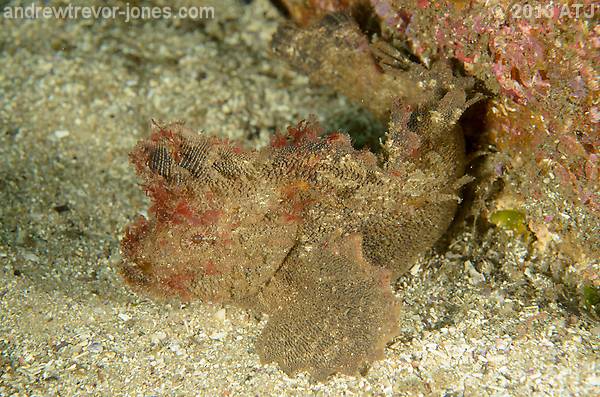
Velvetfish, Aploactisoma milesii.
Another odd organism I have seen at The Leap is the sea spider. Sea spiders aren't true spiders and belong to a different class called Pycnogonida. They do look like spiders and are very small and so are hard to find. I have only seem them once and only at The Leap.
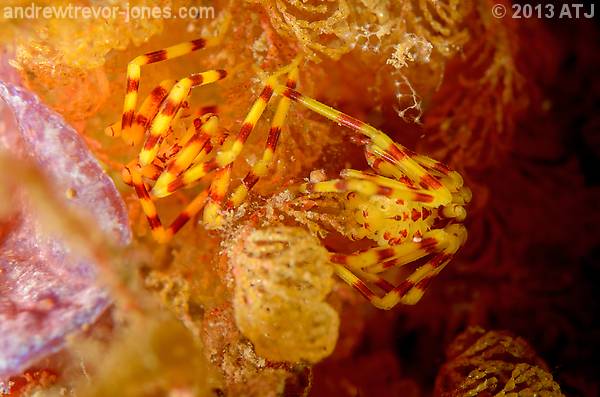
Sea spiders.
Pineapplefish, Cleidopus gloriamaris, are so named because they look like little pineapples. They are common at other dive sites, such as Shiprock on Port Hacking, but I have seen them under a rock overhang about half way between The Leap and The Steps.

Pineapplefish, Cleidopus gloriamaris.
I guess the name, red indianfish, is somewhat politically incorrect these days but it is the accepted common name for Pataecus fronto and they do look like a caricature of a native American. They are generally not a common fish although they are regularly seen at Henry Head and occasionally at Bare Island. I have seen them at The Leap on two occasions, both around the half way point: one on The Leap side of Seadragon Alley and the other on The Steps side. They do look a lot like the red-pink sponges seen in that area and so would be easy to miss.
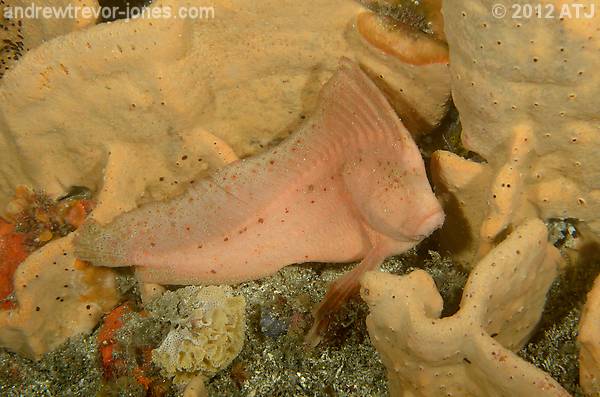
Red indianfish, Pataecus fronto.
I have only ever seen one adult thorny back cowfish, Lactoria fornasini, and I saw it at The Leap in March 2014. I have seen a juvenile at The Monument (north west from The Leap).
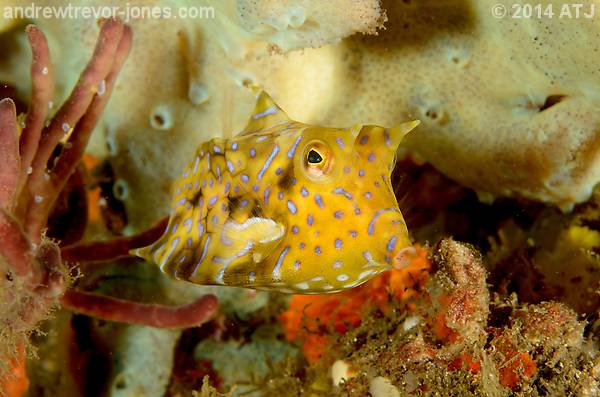
Thorny back cowfish, Lactoria fornasini.
All the nudibranchs commonly seen in Sydney can be seen at The Leap, including: Aphelodoris varia, Ceratosoma amoenum, Chromodoris splendida, Doriprismatica atromarginata, Hypselodoris bennetti and Pteraeolidia ianthina. Additionally, some of the less often seen species are seen there, such as: Flabellina rubrolineata, Jorunna sp. and Okenia hallucigenia.
One of my favourite nudibranchs is Miamira magnifica and I have only ever seen them between The Leap and The Steps. One large individual was around in the same area for 2 months and the last time I saw it it was laying eggs. I have since spotted 2 or 3 other ones.
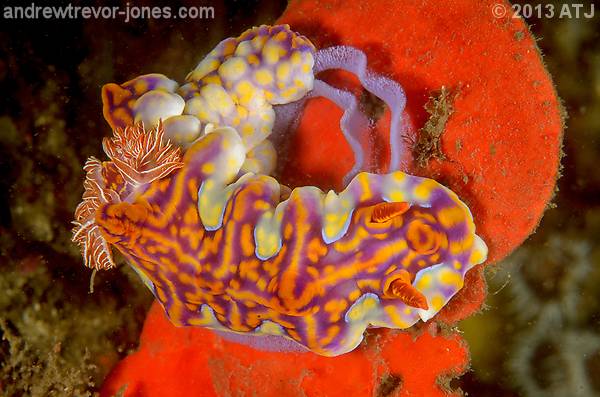
Nudibranch, Miamira magnifica, laying eggs.
The nudibranch, Ceratosoma brevicaudatum is very common at Nelson Bay, but not so common in Sydney. I have seen them at Oak Park and Bare Island, but I have seen 3 at The Leap over the years.

Nudibranch, Ceratosoma brevicaudatum.
One genus of nudibranch I have only seen at The Leap is Janolus. I saw a few individuals in late 2013 and early 2014 but have not seen any since.
From time to time I see spindle cowries, Phenacovolva sp., in Capnella colonies. They seem to hang around for a few weeks and then disappear.
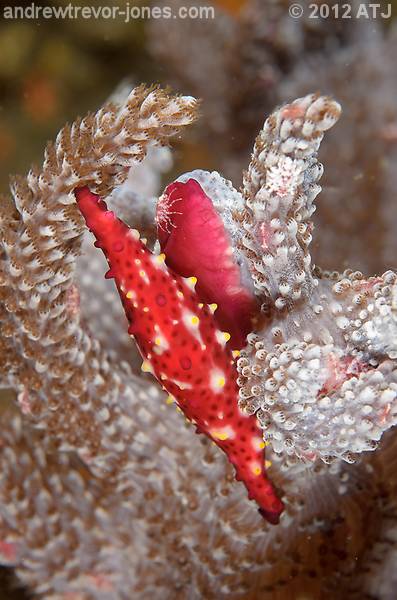
Spindle cowrie, Phenacovolva sp.
All the common sea stars are seen regularly at The Leap, including, red brick sea stars, Pentagonaster duebeni and mosaic sea stars, Plectaster decanus. Another sea star seen on occasions is the biscuit star, Asterodiscides truncatus. These are quite pretty once you get your light on them to highlight their colours.
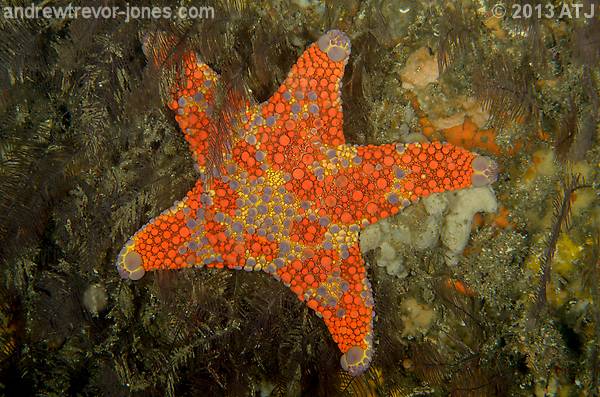
Biscuit star, Asterodiscides truncatus.
Basket stars, Astrosierra amblyconus, can be seen in various places along the way. I have seen them on the wall, a resident on top of one of the large rock shelves about one third of the way and two resident ones closer to The Steps.

One of the resident basket stars, Astrosierra amblyconus, with its arms expanded.
As can be seen from above, there is a rich diversity of organisms at The Leap. Some of them are weird, some are cool and some are pretty but I find them all interesting and they keep drawing me back to dive at The Leap.
Since posting this entry in January I have seen more interesting critters at The Leap and I have done 149 dives in total.
In January, I had a very large Australian fur seal swim around me just after I got in. I shot some video but it really doesn't show it up well. In August, while diving with the Friday Dive Club we had a seal drop in on us while I was looking for pygmy pipehorses. I didn't actually get to see it, but Graeme Heard took a fantastic video:
In July and then again in August I saw a green turtle, Chelonia mydas, in Seadragon Alley. Both times it appeared to be sleeping on the bottom and I was able to approach quite closely before it was disturbed - not that I intended to disturb it.
We have seen a number of stingrays of late, including this huge one from June:
I actually saw the eastern blue devil, Paraplesiops bleekeri, in August 2014 but for some reason forgot to mention it in the original entry.
Three new seahorses have shown up this year and I have seen 15 different pygmy pipehorses. The weedy seadragon population is also doing well.
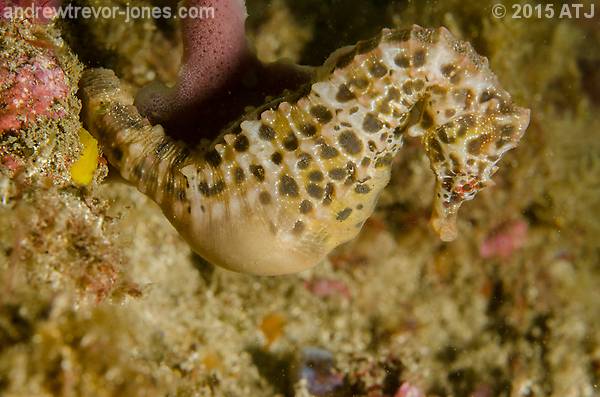
One of the new pot-bellied seahorses, Hippocampus abdominalis, that showed up this year.
Please leave Feedback if you have any comments or questions about this blog entry.